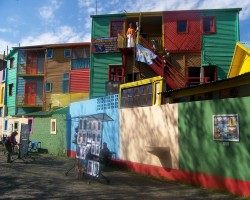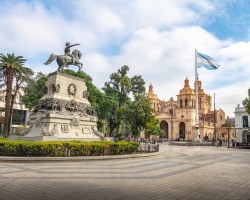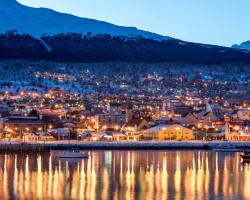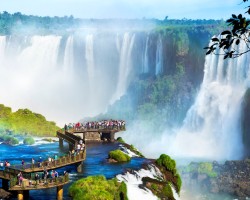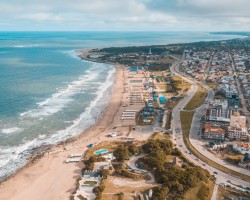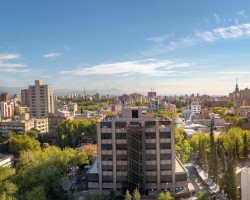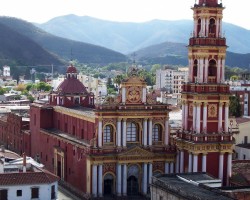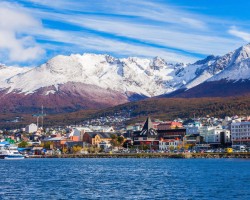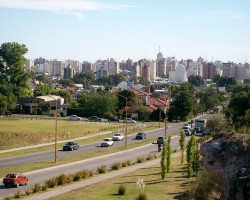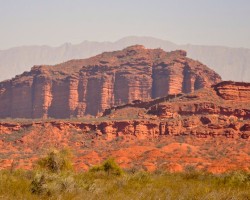Best time to go to Argentina for a perfect weather and where to go?
When is the best time to go to Argentina?
Traveling to Argentina is possible all year round, depending on the region you wish to visit. Indeed, the country stretches along a long distance and Argentinians jokingly say they have their feet in Antarctica and their heads in the tropics!
Being located in the southern hemisphere, the seasons are reversed: summer in Argentina corresponds to winter in Europe.
Therefore, there isn't really a best time to travel to Argentina, but rather more favorable moments than others:
- Summer, from December to March, is the ideal season to discover the south of the country. The temperatures are mild, making the visit more enjoyable. It's also the best time to admire the stunning Iguazu Falls. Conversely, the north suffers from high temperatures and abundant rainfall.
- Winter, between June and September, is the perfect period to explore the north of Argentina. If you're a fan of skiing, you'll have plenty of choices with slopes nestled in the Andes or those in Ushuaia. It's also the season for the southern lights in the south of the country: a grand spectacle! And if you love music, don't miss the World Tango Championship, which takes place every year at the end of August.
When to travel to Argentina to discover the whole country? To avoid extreme temperatures, it's ideal to travel during the shoulder seasons: March-April and October-November. During these periods, it's neither too hot nor too cold, and you can fully enjoy the wonders that Argentina has to offer.
What to pack in your suitcase? Regardless of the time of your trip, bring layers. It can get cold in the south, even in the middle of summer. Also, remember to pack sunscreen, essential in all seasons. Apart from winter, pack light clothing, especially if you're visiting the north of Argentina.
Where and when to go based on the weather?
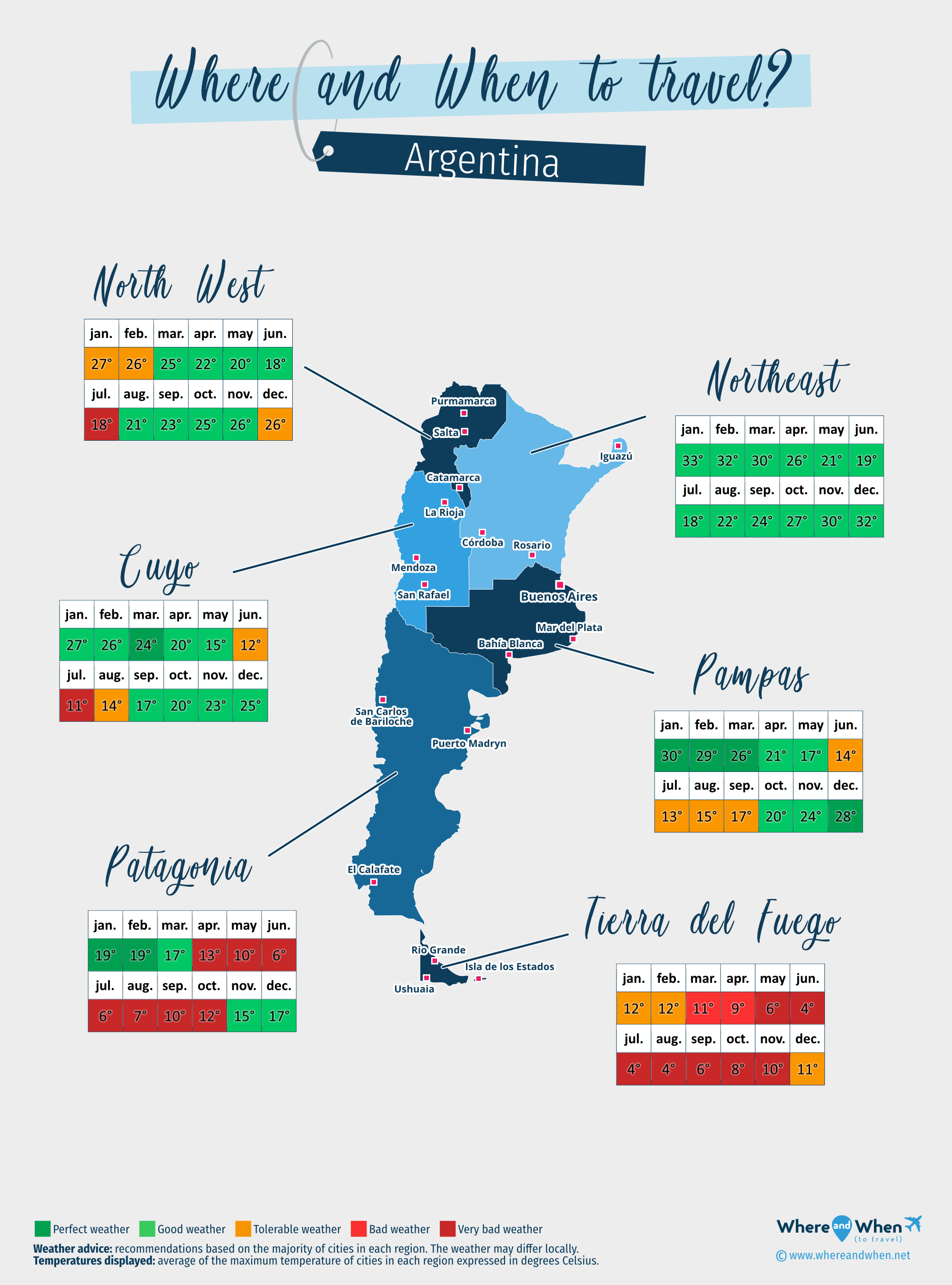
Cuyo
Mendoza, La Rioja, San Rafael...
North West of Argentina
Salta, Purmamarca (Seven Colors Mountain), Catamarca (San Fernando del Valle de Catamarca)...
Northeast of Argentina
Cordoba, Iguazú, Rosario...
Pampas
Buenos Aires, Mar del Plata, Bahía Blanca...
Patagonia
El Calafate, Puerto Madryn, San Carlos de Bariloche...
Tierra del Fuego
Ushuaia, Rio Grande, Isla de los Estados...
To get all the information about the climate and weather in Argentina for a specific month, click on the corresponding link below:
Argentina in january Argentina in february Argentina in march Argentina in april Argentina in may Argentina in june Argentina in july Argentina in august Argentina in september Argentina in october Argentina in november Argentina in december
Best time to travel to Argentina by cities
Climate and Weather in Argentina
Located on the South American continent, between Chile, Uruguay, Brazil, Paraguay, and Bolivia, Argentina stretches from the 22nd to the 56th degree of latitude. Add to this high-altitude reliefs, and you get significant climate variations, especially between the extreme north and south of the country. Thus, Argentina's climate can easily shift from subtropical to subarctic, depending on the regions and seasons.
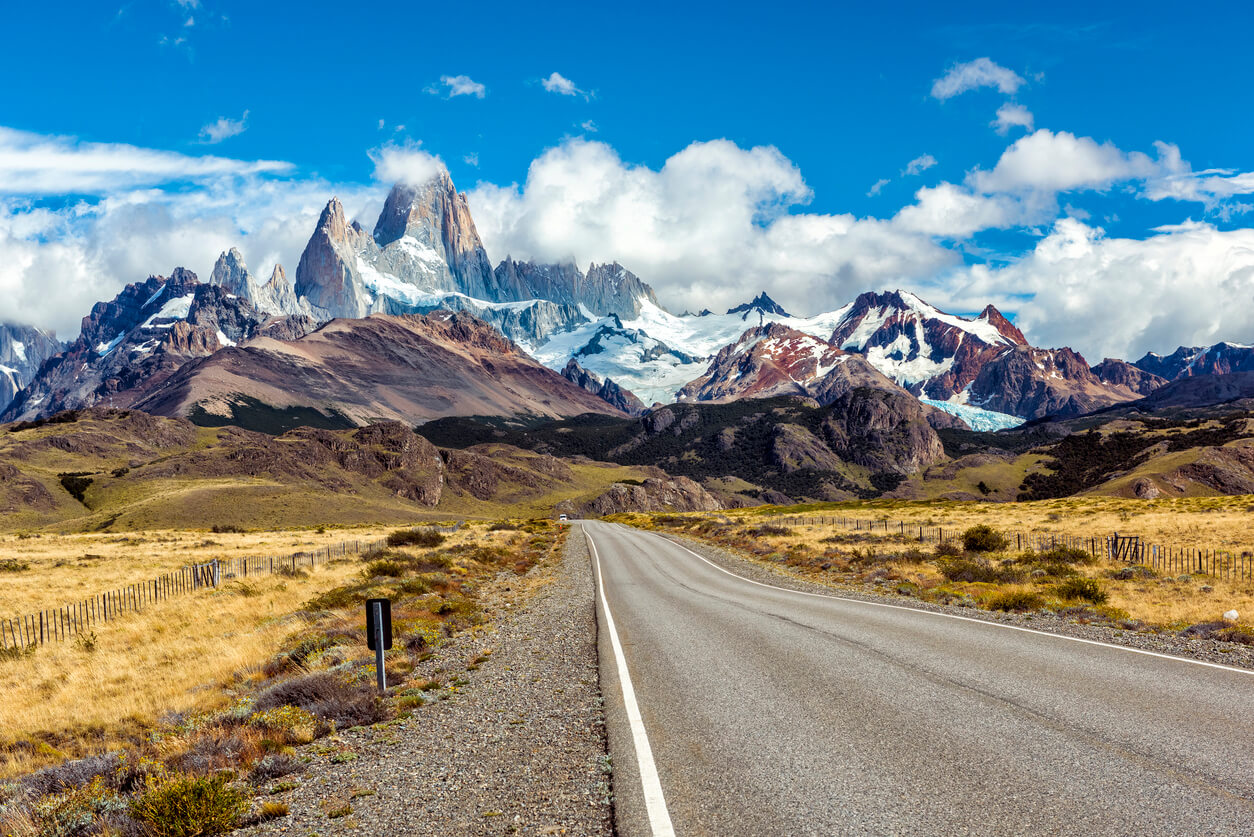
Climate of Northeast Argentina
In northeastern Argentina, residents enjoy a semi-tropical climate. In this area, it is very hot, whether during the dry season, also known as the "wet season," which runs from November to March. Also known as the Mesopotamia, this part of Argentina indeed resembles this ancient region of the Middle East.
Near Iguazú and the famous waterfalls, you are in one of the wettest provinces of northeastern Argentina. The rains are plentiful, but do not lower the temperatures. From May to September, however, daytime temperatures are more bearable and pleasant. In return, these heavy rains increase the flow of the falls, making the spectacle even more fascinating.
Climate of the Buenos Aires Region
The weather in Argentina, around the capital, is milder than in the northeast. The climate is similar to that of the Uruguayan capital, Montevideo.
- Winter can be very cold. It is not the most pleasant time to visit Buenos Aires.
- In spring, between late September and early December, the weather and temperatures are much more pleasant.
- In summer, especially in January, temperatures can be particularly high, often reaching around 40°C (104°F) during the day. Additionally, at the beginning of the year, the city's humidity level is very high.
- In autumn, there are beautiful sunny days, perfect for sightseeing.
Climate of the Northwestern Andes in Argentina
In the Andes, which form the natural border with Chile, the climate is semi-desert:
- In winter, days are mild and nights very cold.
- In spring, the weather is dry, and temperatures are perfect for hiking.
- In summer, temperatures are very hot, and it is not uncommon to see very violent storms hitting the region.
- In autumn, the thermometer drops, but remains at very pleasant levels.
Climate in the Argentine Pampas
A fairly dry region, the Pampas located in the heart of Argentina experiences little rain and a temperate climate. Winters are quite mild, although temperatures can sometimes drop dangerously. In summer, temperatures are very pleasant, although the wind can quickly cool the atmosphere. Therefore, remember to bring warm clothing to explore this region.
Climate in Patagonia and Tierra del Fuego
Located at the southern tip of Argentina, close to the polar circle, these regions have a subarctic climate. Snow is often found throughout Patagonia, and it is not uncommon to feel very cold in Tierra del Fuego, such as in Ushuaia.
- In winter, from June to September, it is the ideal season for skiing and observing marine wildlife along the coasts.
- In summer, from November to March, temperatures are decent, although they can quickly drop with the wind and sunset. It is the ideal time for hiking or trekking.
Temperatures and rainfall in Argentina
On these 3 graphs, we present the evolution of temperatures of Argentina and month-by-month rainfall for the cities of Buenos Aires, Cordoba, El Calafate, Iguazú and Mar del Plata, as well as the month-by-month sea temperature for coastal cities.
Peak visitor numbers and tourist seasons in Argentina
Find out when Argentina has its high tourist season (the period when the influx of tourists is highest) and off-peak tourist season using our data and figures.
Tourist seasons in Argentina
The months with low numbers of tourists are: March, April, May, June, August, September and October. The number of visitors to Argentina is high in: January, February, July, November and December.
- Very low season in Argentina: May and June.
- Low season in Argentina: March, April, August, September and October.
- High season in Argentina: February, July and November.
- Peak season in Argentina: January and December.
Figure: Visitor index for Argentina month by month
Average price for flights to Argentina
A return flight between London and Buenos Aires is generally cheaper if you go in march ($ 1056 on average): this is the best time for travellers on a tight budget. In contrast, you may end up paying $ 375 more for your airline ticket to Buenos Aires if you go in august.
Where to go in Argentina?
This table allows you to see the maximum temperature for each city and our opinion on the weather month by month (see colour legend below the table).
| Cities | jan. | feb. | mar. | apr. | may | jun. | jul. | aug. | sep. | oct. | nov. | dec. |
| Buenos Aires | 86°F | 85°F | 79°F | 74°F | 67°F | 59°F | 58°F | 61°F | 65°F | 70°F | 77°F | 83°F |
| Cordoba | 90°F | 88°F | 83°F | 76°F | 68°F | 65°F | 63°F | 70°F | 74°F | 77°F | 83°F | 88°F |
| El Calafate | 58°F | 58°F | 54°F | 49°F | 41°F | 36°F | 36°F | 38°F | 43°F | 49°F | 52°F | 56°F |
| Iguazú | 90°F | 90°F | 88°F | 83°F | 76°F | 72°F | 72°F | 77°F | 83°F | 85°F | 88°F | 90°F |
| Mar del Plata | 79°F | 77°F | 74°F | 68°F | 61°F | 56°F | 54°F | 58°F | 58°F | 63°F | 68°F | 76°F |
| Mendoza | 85°F | 81°F | 77°F | 70°F | 61°F | 56°F | 54°F | 59°F | 65°F | 70°F | 77°F | 83°F |
| Salta | 77°F | 76°F | 74°F | 70°F | 65°F | 65°F | 65°F | 70°F | 74°F | 76°F | 77°F | 77°F |
| Ushuaia | 54°F | 54°F | 52°F | 47°F | 41°F | 36°F | 36°F | 38°F | 43°F | 47°F | 50°F | 52°F |
| Bahía Blanca | 88°F | 85°F | 81°F | 72°F | 63°F | 58°F | 56°F | 61°F | 65°F | 70°F | 77°F | 85°F |
| Catamarca (San Fernando del Valle de Catamarca) | 83°F | 81°F | 79°F | 74°F | 67°F | 63°F | 63°F | 68°F | 72°F | 77°F | 81°F | 81°F |
| Isla de los Estados | 50°F | 50°F | 50°F | 49°F | 47°F | 43°F | 43°F | 43°F | 43°F | 45°F | 47°F | 49°F |
| La Rioja | 88°F | 85°F | 81°F | 72°F | 63°F | 58°F | 58°F | 65°F | 72°F | 79°F | 85°F | 86°F |
| Puerto Madryn | 83°F | 81°F | 77°F | 70°F | 63°F | 56°F | 54°F | 59°F | 63°F | 68°F | 76°F | 79°F |
| Purmamarca (Seven Colors Mountain) | 77°F | 77°F | 76°F | 72°F | 70°F | 68°F | 67°F | 72°F | 76°F | 77°F | 79°F | 77°F |
| Reconquista | 95°F | 94°F | 88°F | 81°F | 72°F | 67°F | 67°F | 74°F | 77°F | 83°F | 88°F | 92°F |
| Rio Grande | 58°F | 58°F | 54°F | 50°F | 45°F | 41°F | 40°F | 41°F | 45°F | 50°F | 52°F | 56°F |
| Rosario | 95°F | 92°F | 86°F | 77°F | 68°F | 63°F | 63°F | 68°F | 72°F | 77°F | 86°F | 92°F |
| San Carlos de Bariloche | 67°F | 67°F | 61°F | 54°F | 47°F | 41°F | 40°F | 41°F | 47°F | 50°F | 58°F | 63°F |
| San Rafael | 88°F | 85°F | 81°F | 72°F | 65°F | 58°F | 58°F | 63°F | 67°F | 74°F | 81°F | 85°F |
| Santiago del Estero | 94°F | 92°F | 88°F | 81°F | 74°F | 70°F | 68°F | 77°F | 83°F | 86°F | 90°F | 94°F |
Legend:
perfect weather
good weather
tolerable weather
bad weather
very bad weather
About Argentina
What can I do in Argentina?
Beaches / swimming
Nature and countryside
Culture and heritage
Sports
Family travel
Crafts / shopping
Gastronomy
Nightlife
Is this weather information for Argentina reliable?
Climate data for Argentina has been gathered every day since January 2009. The analysis of these meteorological data for Argentina allows us to determine the average for each month in Buenos Aires, Cordoba, El Calafate, Iguazú, Mar del Plata, Mendoza, Salta, Ushuaia, and 67 other cities.
So yes: this data is reliable except in cases of temporary climate disruption in the region.

